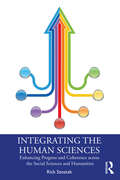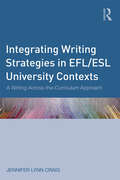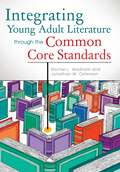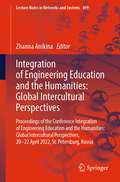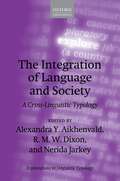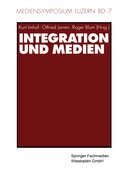- Table View
- List View
Integrated Solid Waste Management: A Lifecycle Inventory
by P.R. White M. Franke P. HindleLife is often considered to be a journey. The lifecycle of waste can similarly be considered to be a journey from the cradle (when an item becomes valueless and, usually, is placed in the dustbin) to the grave (when value is restored by creating usable material or energy; or the waste is transformed into emissions to water or air, or into inert material placed in a landfill). This preface provides a route map for the journey the reader of this book will undertake. Who? Who are the intended readers of this book? Waste managers (whether in public service or private companies) will find a holistic approach for improving the environmental quality and the economic cost of managing waste. The book contains general principles based on cutting edge experience being developed across Europe. Detailed data and a computer model will enable operations managers to develop data-based improvements to their systems. Producers oj waste will be better able to understand how their actions can influence the operation of environmentally improved waste management systems. Designers oj products and packages will be better able to understand how their design criteria can improve the compatibility of their product or package with developing, environmentally improved waste management systems. Waste data specialists (whether in laboratories, consultancies or environ mental managers of waste facilities) will see how the scope, quantity and quality of their data can be improved to help their colleagues design more effective waste management systems.
Integrating Content and Language in Multilingual Universities (Educational Linguistics #44)
by Slobodanka Dimova Joyce KlingThis volume provides conceptual syntheses of diverging multilingual contexts, research findings, and practical applications of integrating content and language (ICL) in higher education in order to generate a new understanding of the cross-contextual variation. With contributions from leading authors based in Asia, the Middle East, and Europe, the volume offers comparison of contextualized overviews of the status of ICL across the geographic areas and allows us to identify patterns and advance the scholarship in the field. ICL in teaching and learning has become an important consideration in the endeavors to address linguistic diversity at universities, which has resulted from the growing teacher and student mobility around the world.
Integrating Information and Communication Technologies in English for Specific Purposes (English Language Education #10)
by Rosa Muñoz-Luna Lidia TailleferThis book fills the need for a text that integrates Information and Communication Technologies (ICTs) into English for Specific Purposes (ESP). It offers insights on current methodological principles in ESP in both academic and professional contexts, drawing on authentic teaching and learning situations, and analyses best practice guidelines. Part I begins with ESP pedagogical principles and technological practice in order to focus on its two main branches: English for Academic Purposes, which includes linguistic skills and students’ needs, and English for Occupational Purposes, specifically looking at Business, Medical and Translators courses. This book is a great resource for ESP researchers, educators and students, because it provides case studies of how ICTs can be used in English for multiple purposes. Authors present their experiences of integrating tools into their instructions, with each chapter contributing unique pedagogical implications.
Integrating Literature in the Content Areas: Enhancing Adolescent Learning and Literacy
by Sharon KaneThis practical, accessible resource will help future and practicing teachers integrate literature into their middle school or high school classrooms, while also addressing content area standards and improving the literacy skills of their students. Two introductory chapters are followed by five chapters that each cover a different genre: Chapter 3, Informational Books; Chapter 4, Fiction; Chapter 5, Biography, Autobiography, and Memoir; Chapter 6, Poetry; and Chapter 7, How-to and Hands-on Books. Each genre chapter consists of four parts: Part 1: Discusses the genre and how content area teachers can use books within that genre to further content learning and enhance literacy skills. Part 2: Offers hands-on instructional strategies and activities using literature, with activities for use in a variety of disciplines. Part 3: Presents individual author studies (three or four per chapter) with bibliographies and guidelines for using the authors' books in content area courses. Part 4: Features an annotated bibliography of specially selected children and young adult literature for that genre, organized by content area. The annotations provide information about the book, which can be used to prepare booktalks, and teaching ideas for using in a specific content area. Altogether these sections contain more than 600 annotated entries tabbed by subject area, including art, English/language arts, languages and culture, math and technology, music, PE/health, science, and social studies/history.
Integrating Literature in the Content Areas: Enhancing Adolescent Learning and Literacy
by Sharon KaneThis practical, accessible resource will help future and practicing teachers integrate literature into their middle school or high school classrooms, while also addressing content area standards and improving the literacy skills of their students. Two introductory chapters are followed by five chapters that each cover a different genre: Chapter 3, Informational Books; Chapter 4, Fiction; Chapter 5, Biography, Autobiography, and Memoir; Chapter 6, Poetry; and Chapter 7, How-to and Hands-on Books. Each genre chapter consists of four parts: Part 1: Discusses the genre and how content area teachers can use books within that genre to further content learning and enhance literacy skills. Part 2: Offers hands-on instructional strategies and activities using literature, with activities for use in a variety of disciplines. Part 3: Presents individual author studies (three or four per chapter) with bibliographies and guidelines for using the authors' books in content area courses. Part 4: Features an annotated bibliography of specially selected children and young adult literature for that genre, organized by content area. The annotations provide information about the book, which can be used to prepare booktalks, and teaching ideas for using in a specific content area. Altogether these sections contain more than 600 annotated entries tabbed by subject area, including art, English/language arts, languages and culture, math and technology, music, PE/health, science, and social studies/history.
Integrating Multiple Literacies in K-8 Classrooms: Cases, Commentaries, and Practical Applications
by Janet C. Richards Michael C. McKennaThis text gives prospective and practicing teachers a comprehensive understanding of how to teach multiple literacies in elementary and middle school classrooms. All of the literacies--dance, music, visual arts, popular culture, media, and computer technologies--are integrated with reading and writing. Balanced treatment is given to theoretical perspectives and practical applications. The text features authentic cases written by preservice teachers, and commentaries on the cases from practitioners and university professors. The cases are designed to prepare future teachers for the PRAXIS teacher certifying exam and others offered in many states. Three theoretical chapters support the practical applications: *Chapter 1 addresses the benefits of writing and analyzing cases and the specific attributes of exemplary teaching cases, and offers guidelines for teachers to author their own case narratives and questions for analyzing and discussing case issues with peers. *Chapter 2 discusses the role of electronic symbol making and multiple sign systems in children's literacy and how children use symbols to receive and express meaning. *Chapter 3 offers a theoretical framework that helps define and enable teachers to use the new literacies of Internet technology, and provides a strong rationale for expanding traditional definitions of literacy. The practical applications chapters (chaps. 4-12) gradually lead readers toward a deeper understanding of how to conceptualize and structure more complex, integrated lessons. In each of these chapters: *An "Overview" provides up-to-date information about the particular form of literacy discussed in the chapter. *A helpful "What Do You Need to Know and How Do You Begin" section offers ideas and tasks for teachers who wish to nurture their artistic and technological aptitudes, expand their understanding of popular culture media, and increase their knowledge about integrating diverse communication forms into cohesive themed units or instruction. *Exemplary cases--the heart of these chapters--present preservice teachers' candid descriptions of their reflections, confusions, and concerns as they support K-8 students writing and writing development through multiple literacy approaches. *Case-specific questions encourage readers to take an active part in analyzing, documenting, and discussing the particular issues raised. *"Commentaries" by skilled practitioners and university professors provide sound teaching suggestions, scholarly perspectives, and sometimes contrasting solutions to the dilemmas described in the cases. *"Reflections and Explorations" activities help teachers become more actively involved in thinking and learning about multiple literacies. *"Practical Applications" questions engage teachers in considering their own teaching environments and goals as they integrate multiple literacy lessons into their curriculum. *"Suggested Readings" support teachers in constructing more in-depth knowledge about the chapter topics.
Integrating Multiple Literacies in K-8 Classrooms: Cases, Commentaries, and Practical Applications
by Janet C. Richards Michael C. McKennaThis text gives prospective and practicing teachers a comprehensive understanding of how to teach multiple literacies in elementary and middle school classrooms. All of the literacies--dance, music, visual arts, popular culture, media, and computer technologies--are integrated with reading and writing. Balanced treatment is given to theoretical perspectives and practical applications. The text features authentic cases written by preservice teachers, and commentaries on the cases from practitioners and university professors. The cases are designed to prepare future teachers for the PRAXIS teacher certifying exam and others offered in many states. Three theoretical chapters support the practical applications: *Chapter 1 addresses the benefits of writing and analyzing cases and the specific attributes of exemplary teaching cases, and offers guidelines for teachers to author their own case narratives and questions for analyzing and discussing case issues with peers. *Chapter 2 discusses the role of electronic symbol making and multiple sign systems in children's literacy and how children use symbols to receive and express meaning. *Chapter 3 offers a theoretical framework that helps define and enable teachers to use the new literacies of Internet technology, and provides a strong rationale for expanding traditional definitions of literacy. The practical applications chapters (chaps. 4-12) gradually lead readers toward a deeper understanding of how to conceptualize and structure more complex, integrated lessons. In each of these chapters: *An "Overview" provides up-to-date information about the particular form of literacy discussed in the chapter. *A helpful "What Do You Need to Know and How Do You Begin" section offers ideas and tasks for teachers who wish to nurture their artistic and technological aptitudes, expand their understanding of popular culture media, and increase their knowledge about integrating diverse communication forms into cohesive themed units or instruction. *Exemplary cases--the heart of these chapters--present preservice teachers' candid descriptions of their reflections, confusions, and concerns as they support K-8 students writing and writing development through multiple literacy approaches. *Case-specific questions encourage readers to take an active part in analyzing, documenting, and discussing the particular issues raised. *"Commentaries" by skilled practitioners and university professors provide sound teaching suggestions, scholarly perspectives, and sometimes contrasting solutions to the dilemmas described in the cases. *"Reflections and Explorations" activities help teachers become more actively involved in thinking and learning about multiple literacies. *"Practical Applications" questions engage teachers in considering their own teaching environments and goals as they integrate multiple literacy lessons into their curriculum. *"Suggested Readings" support teachers in constructing more in-depth knowledge about the chapter topics.
Integrating Social and Emotional Learning with Content: Using Picture Books for Differentiated Teaching in K-3 Classrooms
by Katherine Kapustka Sarah BrightIntegrating Social and Emotional Learning with Content builds a framework for creatively and effectively using picture books to integrate social and emotional learning (SEL) with teaching across content areas. Thoughtful book choices in mixed-ability early elementary classrooms have the power to not only support gifted students as they develop academically, but also to provide an opportunity to address their unique social and emotional needs, such as asynchronous development and an early awareness of complex and challenging issues in their lives and the world at large. Picture books are an invaluable tool for this work because the characters, topics, and settings increasingly represent and celebrate the lived experiences of diverse student populations, supporting culturally responsive teaching. Packed with lesson plans, book lists, and more, this book is perfect for teachers in gifted and mixed-ability classrooms as well as homeschooling parents looking to help their children make meaningful connections between their culture, languages, and lived experiences and the academic content and SEL skills they are being taught in the classroom.
Integrating Social and Emotional Learning with Content: Using Picture Books for Differentiated Teaching in K-3 Classrooms
by Katherine Kapustka Sarah BrightIntegrating Social and Emotional Learning with Content builds a framework for creatively and effectively using picture books to integrate social and emotional learning (SEL) with teaching across content areas. Thoughtful book choices in mixed-ability early elementary classrooms have the power to not only support gifted students as they develop academically, but also to provide an opportunity to address their unique social and emotional needs, such as asynchronous development and an early awareness of complex and challenging issues in their lives and the world at large. Picture books are an invaluable tool for this work because the characters, topics, and settings increasingly represent and celebrate the lived experiences of diverse student populations, supporting culturally responsive teaching. Packed with lesson plans, book lists, and more, this book is perfect for teachers in gifted and mixed-ability classrooms as well as homeschooling parents looking to help their children make meaningful connections between their culture, languages, and lived experiences and the academic content and SEL skills they are being taught in the classroom.
Integrating Technology in English Language Arts Teacher Education (Routledge Research in Teacher Education)
by Donna L. PasternakIntegrating Technology in English Language Arts Teacher Education investigates the technology practices teacher candidates in the US are being introduced to, how they are using these practices in classrooms, and how technology can be effectively integrated into English teacher education programs. By drawing upon findings from extensive longitudinal studies into teacher education programs in the US, this timely volume addresses critical themes relating to the integration of technology in education, including: • Teaching with technology • Technology for collaboration • Technology for individualized learning and assessment By analyzing the experiences of teacher educators and candidates, and offering detailed analysis of the content, practices, and skills being taught to pre-service English teachers, Pasternak examines the entities that drive or inhibit the adoption of technology into the secondary English language arts (ELA) curriculum. This volume will resonate with an international audience of post-graduate scholars and researchers interested in the fields of teacher education, English language arts, and the relationship between technology and classroom practice.
Integrating Technology in English Language Arts Teacher Education (Routledge Research in Teacher Education)
by Donna L. PasternakIntegrating Technology in English Language Arts Teacher Education investigates the technology practices teacher candidates in the US are being introduced to, how they are using these practices in classrooms, and how technology can be effectively integrated into English teacher education programs. By drawing upon findings from extensive longitudinal studies into teacher education programs in the US, this timely volume addresses critical themes relating to the integration of technology in education, including: • Teaching with technology • Technology for collaboration • Technology for individualized learning and assessment By analyzing the experiences of teacher educators and candidates, and offering detailed analysis of the content, practices, and skills being taught to pre-service English teachers, Pasternak examines the entities that drive or inhibit the adoption of technology into the secondary English language arts (ELA) curriculum. This volume will resonate with an international audience of post-graduate scholars and researchers interested in the fields of teacher education, English language arts, and the relationship between technology and classroom practice.
Integrating the Human Sciences: Enhancing Progress and Coherence across the Social Sciences and Humanities
by Rick SzostakWhat if we recognized that the human sciences collectively investigate a few dozen key phenomena that interact with each other? Can we imagine a human science that would seek to stitch its understandings of this system of phenomena into a coherent whole? If so, what would that look like? This book argues that we are unlikely to develop one unified "theory of everything." Our collective understanding must then be a "map" of the myriad relationships within this large – but finite and manageable – system, coupled with detailed understandings of each causal link and of important subsystems. The book outlines such a map and shows that the pursuit of coherence – and a more successful human science enterprise – requires integration, recognizing the strengths and weaknesses of different methods and theory types, and the pursuit of terminological and presentational clarity. It explores how these inter-connected goals can be achieved in research, teaching, library classification, public policy, and university administration. These suggestions are congruent with, and yet enhance, other projects for reform of the human sciences. This volume is aimed at any scholar or student who seeks to comprehend how what they study fits within a broader understanding.
Integrating the Human Sciences: Enhancing Progress and Coherence across the Social Sciences and Humanities
by Rick SzostakWhat if we recognized that the human sciences collectively investigate a few dozen key phenomena that interact with each other? Can we imagine a human science that would seek to stitch its understandings of this system of phenomena into a coherent whole? If so, what would that look like? This book argues that we are unlikely to develop one unified "theory of everything." Our collective understanding must then be a "map" of the myriad relationships within this large – but finite and manageable – system, coupled with detailed understandings of each causal link and of important subsystems. The book outlines such a map and shows that the pursuit of coherence – and a more successful human science enterprise – requires integration, recognizing the strengths and weaknesses of different methods and theory types, and the pursuit of terminological and presentational clarity. It explores how these inter-connected goals can be achieved in research, teaching, library classification, public policy, and university administration. These suggestions are congruent with, and yet enhance, other projects for reform of the human sciences. This volume is aimed at any scholar or student who seeks to comprehend how what they study fits within a broader understanding.
Integrating the Participants’ Perspective in the Study of Language and Communication Disorders: Towards a New Analytical Approach
by Charlotte Marie KlemmensenThis book presents a new analytical approach that will advance the establishment of a new discourse within the study of language and communication disorders. Instances of recurring aphasia and acquired brain injury are discussed in an empirical observation study through a theoretical lens that combines Integrational Linguistics, ethnomethodology, Conversation Analysis and practice theory. In doing so, this interdisciplinary analysis adds a person-centered perspective to existing ethnographic approaches. It addresses a significant gap in our understanding of the social/communicative/interactional consequences of brain injury for everyday life by focusing on the practical problems that individuals with communication difficulties and acquired brain damage - and their care-takers, family and friends - have to solve in everyday life, and how they solve them. This innovative work will appeal to health and social care practitioners and care-givers, in addition to scholars of health communication, cognitive, psycho- and sociolinguistics.
Integrating the Participants’ Perspective in the Study of Language and Communication Disorders: Towards a New Analytical Approach
by Charlotte Marie KlemmensenThis book presents a new analytical approach that will advance the establishment of a new discourse within the study of language and communication disorders. Instances of recurring aphasia and acquired brain injury are discussed in an empirical observation study through a theoretical lens that combines Integrational Linguistics, ethnomethodology, Conversation Analysis and practice theory. In doing so, this interdisciplinary analysis adds a person-centered perspective to existing ethnographic approaches. It addresses a significant gap in our understanding of the social/communicative/interactional consequences of brain injury for everyday life by focusing on the practical problems that individuals with communication difficulties and acquired brain damage - and their care-takers, family and friends - have to solve in everyday life, and how they solve them. This innovative work will appeal to health and social care practitioners and care-givers, in addition to scholars of health communication, cognitive, psycho- and sociolinguistics.
Integrating Virtual and Traditional Learning in 6-12 Classrooms: A Layered Literacies Approach to Multimodal Meaning Making
by Sandra Schamroth AbramsIntegrating Virtual and Traditional Learning in 6-12 Classrooms introduces a model of "layered literacies" as a framework for describing and illustrating how students’ digital experiences can inform educational methods. Through the lens of layered literacies, educators can envision opportunities to draw upon adolescents’ out-of-school interests and activities to meaningfully integrate digital practices within academic contexts. Such an approach facilitates innovative teaching, inspired learning, and successful pedagogy, and it thoughtfully highlights the role of technology within mandated standards-based instruction in public schools. Combining foundational and contemporary theories, supported by data from multiple studies of adolescent learning, and honoring teachers’ and students’ experiences and resources, this text helps educators reconceptualize the ways students learn through and with digital texts and negotiate the connection between online and offline spaces. A companion website extends the discussion onto the screen, engaging readers in an intertextual approach to learning that complements the concept of layering literacies across disciplines. With a foreword by Jennifer Rowsell and an afterword by Bill Cope and Mary Kalantzis, it will be of interest to experienced educators and administrators, as well as postgraduate, graduate, and undergraduate students of education.
Integrating Virtual and Traditional Learning in 6-12 Classrooms: A Layered Literacies Approach to Multimodal Meaning Making
by Sandra Schamroth AbramsIntegrating Virtual and Traditional Learning in 6-12 Classrooms introduces a model of "layered literacies" as a framework for describing and illustrating how students’ digital experiences can inform educational methods. Through the lens of layered literacies, educators can envision opportunities to draw upon adolescents’ out-of-school interests and activities to meaningfully integrate digital practices within academic contexts. Such an approach facilitates innovative teaching, inspired learning, and successful pedagogy, and it thoughtfully highlights the role of technology within mandated standards-based instruction in public schools. Combining foundational and contemporary theories, supported by data from multiple studies of adolescent learning, and honoring teachers’ and students’ experiences and resources, this text helps educators reconceptualize the ways students learn through and with digital texts and negotiate the connection between online and offline spaces. A companion website extends the discussion onto the screen, engaging readers in an intertextual approach to learning that complements the concept of layering literacies across disciplines. With a foreword by Jennifer Rowsell and an afterword by Bill Cope and Mary Kalantzis, it will be of interest to experienced educators and administrators, as well as postgraduate, graduate, and undergraduate students of education.
Integrating Writing Strategies in EFL/ESL University Contexts: A Writing-Across-the-Curriculum Approach
by Jennifer Lynn CraigClearly explaining writing-across-the-curriculum (WAC) pedagogy for English language teachers in university settings, this book offers an accessible guide to integrating writing and speaking tasks across the curriculum and in disciplinary courses. Teachers will find this book useful because its direct, practical advice can be easily incorporated in their classrooms to help their students develop advanced disciplinary English skills in writing, oral presentation, and graphical presentation. Enhancing its usefulness and relevance, each chapter includes coverage of the use of technology for teaching and learning; ways in which teachers can effectively and efficiently assess writing and speaking; and vignettes or examples to Illustrate writing strategies or assignments in different contexts. Pulling together the key features of writing-across-the-curriculum in one volume this book, is an efficient resource for busy EFL/ESL teachers worldwide.
Integrating Writing Strategies in EFL/ESL University Contexts: A Writing-Across-the-Curriculum Approach
by Jennifer Lynn CraigClearly explaining writing-across-the-curriculum (WAC) pedagogy for English language teachers in university settings, this book offers an accessible guide to integrating writing and speaking tasks across the curriculum and in disciplinary courses. Teachers will find this book useful because its direct, practical advice can be easily incorporated in their classrooms to help their students develop advanced disciplinary English skills in writing, oral presentation, and graphical presentation. Enhancing its usefulness and relevance, each chapter includes coverage of the use of technology for teaching and learning; ways in which teachers can effectively and efficiently assess writing and speaking; and vignettes or examples to Illustrate writing strategies or assignments in different contexts. Pulling together the key features of writing-across-the-curriculum in one volume this book, is an efficient resource for busy EFL/ESL teachers worldwide.
Integrating Young Adult Literature through the Common Core Standards
by Rachel L. Wadham Jon W. OstensonThis book advocates for a stronger role for young-adult literature in ELA classrooms, compellingly documenting how this body of work meets both the needs of adolescent students and the demands of the common core for complex texts and tasks.Integrating Young Adult Literature through the Common Core Standards provides a compelling template for teachers that uses young adult literature and inquiry learning to meet students' needs and the demands of the common core standards.The first part of the book addresses the widely adopted common core state standards by examining closely the standards' model of text complexity and demonstrating how young adult literature can fill the requirements of this model. The second part provides theoretical discussions and analysis of the standards as well as concrete applications of young adult literature within the classroom in order to give school professionals a comprehensive understanding of how young adult literature and the standards can work together. The book empowers schools and teachers to make intelligent, informed decisions about texts and instructional practices that benefit their students.Finally, the authors explore a powerful teaching approach that integrates current understandings about learning, young adult literature, and the common core standards in a way that will facilitate greater learning and understanding in English classrooms.
Integrating Young Adult Literature through the Common Core Standards
by Rachel L. Wadham Jon W. OstensonThis book advocates for a stronger role for young-adult literature in ELA classrooms, compellingly documenting how this body of work meets both the needs of adolescent students and the demands of the common core for complex texts and tasks.Integrating Young Adult Literature through the Common Core Standards provides a compelling template for teachers that uses young adult literature and inquiry learning to meet students' needs and the demands of the common core standards.The first part of the book addresses the widely adopted common core state standards by examining closely the standards' model of text complexity and demonstrating how young adult literature can fill the requirements of this model. The second part provides theoretical discussions and analysis of the standards as well as concrete applications of young adult literature within the classroom in order to give school professionals a comprehensive understanding of how young adult literature and the standards can work together. The book empowers schools and teachers to make intelligent, informed decisions about texts and instructional practices that benefit their students.Finally, the authors explore a powerful teaching approach that integrates current understandings about learning, young adult literature, and the common core standards in a way that will facilitate greater learning and understanding in English classrooms.
Integration of Engineering Education and the Humanities: Proceedings of the Conference Integrating Engineering Education and Humanities for Global Intercultural Perspectives, 20–22 April 2022, St. Petersburg, Russia (Lecture Notes in Networks and Systems #499)
by Zhanna AnikinaThis book tackles the problems of engineering students and teachers while developing language skills through language education, transforming students’ mind-set through cultural studies, developing students’ intellectual abilities and personal qualities, and the use of information technologies in order to enhance the educational process. The International Conference Integration of Engineering Education and the Humanities: Global Intercultural Perspectives will take place 20–22 April 2022. It will be organized by Peter the Great Saint Petersburg Polytechnic University (Saint Petersburg, Russia) in collaboration with Research Centre Kairos (Tomsk, Russia). The event aims to raise discussions around a variety of aspects related to the integration of the humanities into engineering education.As such, the book will be of interest to the teachers, researchers and institutional leaders looking for the latest insights, experiences and research results on the topic.
The Integration of Language and Society: A Cross-Linguistic Typology (Explorations in Linguistic Typology)
The volume explores the integration of language and society as reflected in the grammar of a language. Each language bears an imprint of the society that speaks it; language reflects speakers' relationships with each other, their beliefs, and their ways of viewing the world, as well as other aspects of their social environment, their means of subsistence, and even geographical features of the areas in which the language is spoken. The chapters in this book draw on data from the languages of Australia and New Guinea (Dyirbal and Idi), South America (Chamacoco, Ayoreo, Murui, and Tariana), Asia (Japanese, Brokpa, and Dzongkha), and Africa (Iraqw) to examine the ways in which the grammar of a language relates to societal practices. The volume begins with a general introduction that summarizes the main issues relevant to how language and societies are integrated, before later chapters explore specific points of integration in a range of diverse languages, including honorifics, genders and classifiers, possessives, evidentiality, comparatives, and demonstratives. The findings advance our understanding of how non-linguistic traits have their correlates in language, and how these change when society changes. The volume will be a valuable resource for scholars and students of typology, cultural and linguistic anthropology, and sociolinguistics and social sciences more widely.
The Integration of Phonetic Knowledge in Speech Technology (Text, Speech and Language Technology #25)
by William J. Barry Wim A. Van DommelenContinued progress in Speech Technology in the face of ever-increasing demands on the performance levels of applications is a challenge to the whole speech and language science community. Robust recognition and understanding of spontaneous speech in varied environments, good comprehensibility and naturalness of expressive speech synthesis are goals that cannot be achieved without a change of paradigm. This book argues for interdisciplinary communication and cooperation in problem-solving in general, and discusses the interaction between speech and language engineering and phonetics in particular. With a number of reports on innovative speech technology research as well as more theoretical discussions, it addresses the practical, scientific and sometimes the philosophical problems that stand in the way of cross-disciplinary collaboration and illuminates some of the many possible ways forward. Audience: Researchers and professionals in speech technology and computational linguists.
Integration und Medien (Mediensymposium #7)
by Kurt Imhof Otfried Jarren Roger BlumBei aller Mannigfaltigkeit der sozialwissenschaftlichen Theorien lässt sich ein gemeinsamer Begriff ausmachen, der sämtliche Theorieschulen oder -schwärme kennzeichnet: die zentrale Bedeutung des Terminus Kommunikation. Im Licht dieser Fundamentalkategorie und unter dem Eindruck der mediengesellschaftlichen Entwicklungsdynamik rücken mehr und mehr die Interdependenz zwischen dem Mediensystem und anderen Teilsystemen ausdifferenzierter Gesellschaften in den Fokus der Diskussionen.








